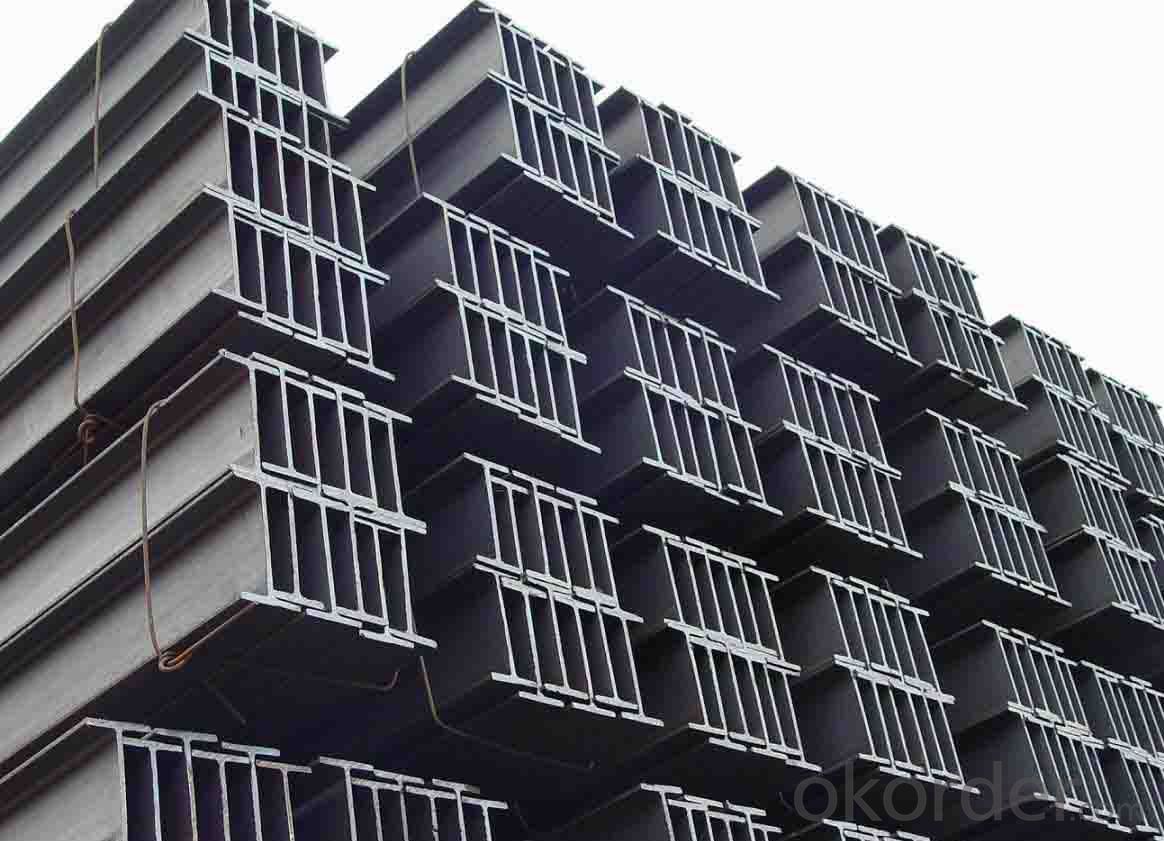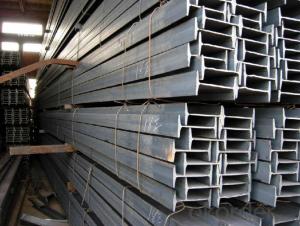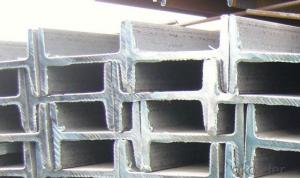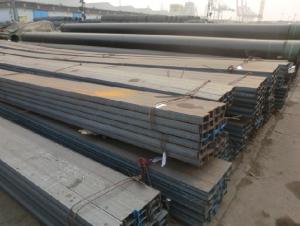IPE/IPEAA Beam with Material Grade GB-Q235
- Loading Port:
- Tianjin
- Payment Terms:
- TT OR LC
- Min Order Qty:
- 25 m.t.
- Supply Capability:
- 10000 m.t./month
OKorder Service Pledge
OKorder Financial Service
You Might Also Like
Product Description:
OKorder is offering high quality Hot Rolled Steel I-Beams at great prices with worldwide shipping. Our supplier is a world-class manufacturer of steel, with our products utilized the world over. OKorder annually supplies products to European, North American and Asian markets. We provide quotations within 24 hours of receiving an inquiry and guarantee competitive prices.
Product Applications:
1. Supporting members, most commonly in the house raising industry to strengthen timber bears under houses. Transmission line towers, etc
2. Prefabricated structure
3. Medium scale bridges
4. It is widely used in various building structures and engineering structures such as roof beams, bridges, transmission towers, hoisting machinery and transport machinery, ships, industrial furnaces, reaction tower, container frame and warehouse etc.
Product Advantages:
OKorder's Steel I-Beams are durable, strong, and resist corrosion.
Main Product Features:
· Premium quality
· Prompt delivery & seaworthy packing (30 days after receiving deposit)
· Corrosion resistance
· Can be recycled and reused
· Mill test certification
· Professional Service
· Competitive pricing
Product Specifications:
1. Invoicing on theoretical weight or actual weight as customer request
2. Standard: EN10025, GB Standard, ASTM
3. Grade: Q235B, Q345B, SS400, ASTM A36, S235JR, S275JR
4. Length: 5.8M, 6M, 9M, 12M as following table
5. Sizes: 80mm-270mm
Dimensions(mm) | |||||
h | b | s | t | Mass Kg/m | |
IPE80 | 80 | 46 | 3.80 | 5.20 | 6.00 |
IPE100 | 100 | 55 | 4.10 | 5.70 | 8.10 |
IPE120 | 120 | 64 | 4.80 | 6.30 | 10.40 |
IPE140 | 140 | 73 | 4.70 | 6.90 | 12.90 |
IPE160 | 160 | 82 | 5.00 | 7.40 | 15.80 |
IPE180 | 180 | 91 | 5.30 | 8.00 | 18.80 |
IPE200 | 200 | 100 | 5.60 | 8.50 | 22.40 |
IPE220 | 220 | 110 | 5.90 | 9.20 | 26.20 |
IPE240 | 240 | 120 | 6.20 | 9.80 | 30.70 |
IPE270 | 270 | 135 | 6.60 | 10.20 | 36.10 |
FAQ:
Q1: Why buy Materials & Equipment from OKorder.com?
A1: All products offered byOKorder.com are carefully selected from China's most reliable manufacturing enterprises. Through its ISO certifications, OKorder.com adheres to the highest standards and a commitment to supply chain safety and customer satisfaction.
Q2: How do we guarantee the quality of our products?
A2: We have established an advanced quality management system which conducts strict quality tests at every step, from raw materials to the final product. At the same time, we provide extensive follow-up service assurances as required.
Q3: How soon can we receive the product after purchase?
A3: Within three days of placing an order, we will begin production. The specific shipping date is dependent upon international and government factors, but is typically 7 to 10 workdays.
Images:


- Q:What are the environmental impacts of steel I-beam production?
- The environmental impacts of steel I-beam production include carbon dioxide emissions from the energy-intensive manufacturing process, deforestation and habitat destruction due to iron ore extraction, water pollution from mining activities, and the generation of waste materials such as slag and scale. Additionally, the transportation of raw materials and finished products contributes to air pollution and greenhouse gas emissions. However, advancements in technology and sustainable practices are being implemented to reduce these impacts.
- Q:What are the standard sizes and dimensions of steel I-beams?
- The standard sizes and dimensions of steel I-beams vary depending on the specific requirements and industry standards. However, some common standard sizes include 3", 4", 6", 8", 10", 12", 14", 16", 18", 20", 22", 24", and larger. These dimensions refer to the height of the beam, while the width can range from 1.375" to 12.25" or more. The weight per foot and length of the beam also vary based on the size and type of I-beam.
- Q:Can steel I-beams be used in sports arenas or stadiums?
- Yes, steel I-beams can be used in sports arenas or stadiums. They are commonly used in the construction of large-scale structures due to their strength, durability, and ability to support heavy loads.
- Q:Are steel I-beams suitable for load-bearing walls?
- No, steel I-beams are typically not suitable for load-bearing walls. They are primarily used as horizontal structural members to support beams or joists, not for vertical support. Load-bearing walls usually require more robust construction methods such as concrete or masonry.
- Q:Can steel I-beams be used for railway or subway station platforms?
- Indeed, railway or subway station platforms can employ steel I-beams. These beams are popularly utilized in construction owing to their robustness and endurance, rendering them apt for bearing substantial burdens and furnishing a steadfast foundation for railway or subway stations. Moreover, steel I-beams can be manufactured and tailored in accordance with the platform's precise prerequisites, encompassing dimensions like length, width, and height, thereby permitting design adaptability. By employing steel I-beams in railway or subway station platforms, the structure's safety and stability are guaranteed, rendering them a trustworthy selection for such purposes.
- Q:Can steel I-beams be used in elevated walkway construction?
- Yes, steel I-beams can be used in elevated walkway construction. Steel I-beams are commonly used in construction due to their strength, durability, and ability to support heavy loads. They provide structural stability and can be easily fabricated to meet the specific requirements of elevated walkways.
- Q:What are the different methods of protecting steel I-beams from moisture or water damage?
- There are several methods to protect steel I-beams from moisture or water damage. One common approach is to apply a waterproof coating or paint on the surface of the beams, which forms a protective barrier against moisture. Another method is to use corrosion-resistant materials, such as stainless steel or galvanized steel, for the I-beams to prevent water damage. Additionally, proper insulation and ventilation systems can be installed to minimize condensation and moisture accumulation on the beams. Regular inspections and maintenance, including sealing any cracks or gaps, can also help protect the steel I-beams from water damage in the long run.
- Q:How do steel I-beams perform in terms of vibration resistance?
- Steel I-beams are known for their excellent vibration resistance, making them a preferred choice in structural applications where minimizing vibrations is crucial. The inherent stiffness and rigidity of steel I-beams help to dampen and dissipate vibrations, ensuring stability and preventing excessive movement. Additionally, their high strength-to-weight ratio further enhances their ability to withstand dynamic loads and reduces the risk of resonance or vibration amplification. Thus, steel I-beams exhibit exceptional performance in terms of vibration resistance, making them reliable and dependable structural components.
- Q:How do steel I-beams perform in terms of vibration insulation?
- Despite their excellent structural strength and load-bearing capacity, steel I-beams may not be the most effective choice when it comes to vibration insulation. Their rigid and inflexible nature tends to transmit vibrations rather than absorb or dampen them. Consequently, when exposed to vibrations caused by heavy machinery, earthquakes, or nearby traffic, steel I-beams can propagate these vibrations throughout the structure, potentially causing discomfort, noise, and even structural damage. To enhance the vibration insulation capabilities of steel I-beams, various measures can be taken. One commonly used approach is the incorporation of vibration isolation materials or techniques. These can involve the utilization of specialized rubber pads, foam inserts, or flexible connectors positioned between the steel beams and the surrounding structure. These materials and techniques are specifically designed to absorb and dampen vibrations, thereby reducing their transmission through the building. Another option involves implementing structural modifications that enhance the vibration insulation properties of steel I-beams. For instance, adding additional mass to the beams, such as by attaching concrete or other heavy materials, can help mitigate the transmission of vibrations. Additionally, introducing damping elements like tuned mass dampers or viscoelastic materials can effectively dissipate and attenuate vibrations, ultimately improving the overall vibration insulation performance. It is important to recognize that although steel I-beams may not possess inherent vibration insulation capabilities, they are often preferred for their strength, durability, and cost-effectiveness in structural applications. Therefore, a combination of appropriate design, engineering, and additional measures can be employed to minimize the adverse effects of vibrations and optimize the vibration insulation performance of steel I-beams.
- Q:Can steel I-beams be used in bridges?
- Yes, steel I-beams are commonly used in bridge construction. Steel I-beams offer several advantages that make them ideal for bridge applications. Firstly, they have a high strength-to-weight ratio, which means they can support heavy loads while remaining relatively lightweight. This makes them efficient in terms of material usage and allows for longer spans without the need for additional supports. Additionally, steel I-beams have excellent resistance to corrosion, which is crucial for bridges that are constantly exposed to harsh weather conditions. They can be treated with protective coatings or galvanized to further enhance their durability and longevity. Moreover, steel I-beams are versatile and can be fabricated to meet specific design requirements. They can be easily modified and joined together to create different bridge configurations, allowing for flexibility in bridge design. Overall, steel I-beams are a popular choice for bridges due to their strength, durability, and versatility. They have been widely used in various bridge projects around the world, showcasing their reliability and effectiveness in providing stable and long-lasting structures.
1. Manufacturer Overview |
|
|---|---|
| Location | |
| Year Established | |
| Annual Output Value | |
| Main Markets | |
| Company Certifications | |
2. Manufacturer Certificates |
|
|---|---|
| a) Certification Name | |
| Range | |
| Reference | |
| Validity Period | |
3. Manufacturer Capability |
|
|---|---|
| a)Trade Capacity | |
| Nearest Port | |
| Export Percentage | |
| No.of Employees in Trade Department | |
| Language Spoken: | |
| b)Factory Information | |
| Factory Size: | |
| No. of Production Lines | |
| Contract Manufacturing | |
| Product Price Range | |
Send your message to us
IPE/IPEAA Beam with Material Grade GB-Q235
- Loading Port:
- Tianjin
- Payment Terms:
- TT OR LC
- Min Order Qty:
- 25 m.t.
- Supply Capability:
- 10000 m.t./month
OKorder Service Pledge
OKorder Financial Service
Similar products
New products
Hot products
Hot Searches
Related keywords




























